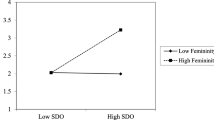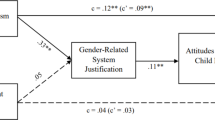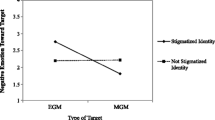Abstract
Prejudicial attitudes and discrimination toward gay men is a common social problem in Turkey as it is in many other countries. It is important to understand the reasons behind the prejudice against gay men in a sexist and Muslim country, Turkey. The purpose of the study was to predict attitudes toward gay men with ambivalent attitudes toward men (hostility toward men, and benevolence toward men), questioning religion, and gender differences. Three hundred seventy-two (91 male and 281 female) heterosexual Muslim students from several universities in Ankara completed Attitudes toward Gay men Scale, Ambivalence toward Men Inventory, and Questioning Religion Scale. The mean age of the participants was 22.79 (SD = 3.07). Results, in general, demonstrated that gender differences, benevolence toward men, and questioning religion predicted attitudes toward gay men. Men were more prejudiced against gay men than women. Participants who scored high on benevolence toward men and low on questioning religion were also more prejudiced against gay men than those who scored low on benevolence toward men and high on questioning religion. Further, gender differences was a moderator variable for the association between hostility toward men and attitudes toward gay men. When the regression analyses were performed separately for female and male participants, it was seen that hostility toward men, benevolence toward men, and questioning religion predicted attitudes toward gay men for women whereas for men only benevolence toward men and questioning religion predicted attitudes toward gay men. Results were discussed in the light of relevant literature.
Similar content being viewed by others
References
Aguero, J. E., Bloch, L., & Byrne, D. (1984). The relationships among sexual beliefs, attitudes, experience, and homophobia. Journal of Homosexuality, 10, 95–107. doi:10.1300/J082v10n01_07.
Alauddin, M., & Son Ngheim, H. (2010). Do instructional attributes pose multicollinearity problems? An empirical exploration. Journal of Economic Analysis and Policy, 49, 351–361. doi:10.1016/S0313-5926(10)50034-1.
Bassett, R. L., Hodak, E., Allen, J., Bartos, D., Grastorf, J., Sittig, L., & Strong, J. (2005). Homonegative Christians: Loving the sinner but hating the sin. Journal of Psychology and Christianity, 19, 258–269.
Batson, C. D., Floyd, R. B., Meyer, J. M., & Winner, A. L. (1999). “And who is my neighbor?”: Intrinsic religion as a source of universal compassion. Journal for the Scientific Study of Religion, 38, 445–457. doi:10.2307/1387605.
Burn, S. M., & Busso, J. (2005). Ambivalent sexism, scriptural literalism, and religiosity. Psychology of Women Quarterly, 29, 412–418. doi:10.1111/j.1471-6402.2005.00241.x.
Chonody, J., Woodford, M. R., Smith, S., & Silverschanz, P. (2013). Christian social work students’ attitudes toward lesbians and gay men: Religious teachings, religiosity, and contact. Journal of Religion & Spirituality in Social Work: Social Thought, 32, 211–232. doi:10.1080/15426432.2013.801730.
Deaux, K., & Lewis, L. L. (1984). Structure of gender stereotypes: Interrelationships among components and gender label. Journal of Personality and Social Psychology, 46, 991–1004. doi:10.1037/0022-3514.46.5.991.
Diyanet İşleri Başkanlığı [Presidency of Religious Affairs]. (2014). Türkiye’de dini yaşam araştırması [Research on religious life in Turkey]. Ankara: Diyanet İşleri Başkanlığı.
Duyan, V., & Gelbal, S. (2004). Attitudes Toward Lesbians and Gays (LGYT) Scale: Reliability and validity study. Turkish Journal of HIV/AIDS, 7, 106–112.
Eagly, A. H., & Steffen, V. (1984). Gender stereotypes stem from the distribution of women and men into social roles. Journal of Personality and Social Psychology, 46, 735–754. doi:10.1037/0022-3514.46.4.735.
Fiske, S. T., & Glick, P. (1995). Ambivalence and stereotypes cause sexual harassment: A theory with implications for organizational change. Journal of Social Issues, 51, 97–115. doi:10.1111/j.1540-4560.1995.tb01311.x.
Ford, T. E., Bringall, T., VanValey, T. L., & Macaluso, M. J. (2009). The unmaking of prejudice: How Christian beliefs relate to attitudes toward homosexuals. Journal for the Scientific Study of Religion, 48, 146–160. doi:10.1111/j.1468-5906.2009.01434.x.
Fulton, A. S., Gorsuch, R. L., & Maynard, E. A. (1999). Religious orientation, antihomosexual sentiment, and fundamentalism among Christians. Journal for the Scientific Study of Religion, 38, 14–22. doi:10.2307/1387580.
Gaunt, R. (2012). “Blessed is he who has not made me a woman”: Ambivalent sexism and Jewish religiosity. Sex Roles, 67, 1323–1334. doi:10.1177/01461672972312009.
Gelbal, S., & Duyan, V. (2006). Attitudes of university students toward lesbians and gay men in Turkey. Sex Roles, 55, 573–579. doi:10.1007/s11199-006-9112-1.
Glick, P., & Fiske, T. S. (1996). The ambivalent sexism inventory: Differentiating hostile and benevolent sexism. Journal of Personality and Social Psychology, 70, 491–512. doi:10.1037/0022-3514.70.3.491.
Glick, P., & Fiske, T. S. (1997). Hostile and benevolent sexism: Measuring ambivalent sexist attitudes toward women. Psychology of Women Quarterly, 21, 119–135. doi:10.1111/j.1471-6402.1997.tb00104.x.
Glick, P., & Fiske, S. T. (1999). The ambivalence toward men inventory: Differentiating hostile and benevolent beliefs about men. Psychology of Women Quarterly, 23, 519–536. doi:10.1111/j.1471-6402.1999.tb00379.x.
Glick, P., & Fiske, S. T. (2001). An ambivalent alliance: Hostile and benevolent sexism as complementary justifications for gender inequality. American Psychologist, 56, 109–118. doi:10.1037/0003-066X.56.2.109.
Glick, P., Diebold, J., Bailey-Werner, B., & Zhu, L. (1997). The two faces of Adam: Ambivalent sexism and polarized attitudes toward women. Personality and Social Psychology Bulletin, 23, 1323–1334. doi:10.1177/01461672972312009.
Glick, P., Lameiras, M., Fiske, S. T., Eckes, T., Masser, B., Volpato, C., … Wells, R. (2004). Bad but bold: Ambivalent attitudes toward men predict gender inequality in 16 nations. Journal of Personality and Social Psychology, 86, 713–728. doi: 10.1037/0022-3514.86.5.713
Habib, S. (2007). Female homosexuality in the Middle East: Histories and representations. New York: Routledge.
Herek, G. M. (1988). Heterosexuals’ attitudes toward lesbians and gay men: Correlates and gender differences. Journal of Sex Research, 25, 451–477. doi:10.1080/00224498809551476.
Herek, G. M. (1998). The attitudes toward lesbians and gay men (ATLG) scale. In C. M. Davis, W. H. Yarber, R. Bauserman, G. Schreer, & S. L. Davis (Eds.), Handbook of sexuality-related measures (pp. 392–394). Thousand Oaks: Sage.
Herek, G. M., & Capitanio, J. P. (1996). “Some of my best friends”: Intergroup contact, concealable stigma, and heterosexuals’ attitudes toward gay men and lesbians. Personality and Social Psychology Bulletin, 22, 412–424. doi:10.1177/0146167296224007.
Hojat, M., Shapurian, R., Nayerahmadi, H., Farzaneh, M., Foroughi, D., Parsi, M., & Azizi, M. (1999). Premarital sexual, child rearing, and family attitudes of Iranian men and women in the United States and Iran. Journal of Psychology, 133, 19–31. doi:10.1080/00223989909599719.
Hunsberger, B., & Jackson, L. M. (2005). Religion, meaning, and prejudice. Journal of Social Issues, 61, 807–826. doi:10.1111/j.1540-4560.2005.00433.x.
Hunsberger, B., Owusu, V., & Duck, R. (1999). Religion and prejudice in Ghana and Canada: Religious fundamentalism, right-wing authoritarianism, and attitudes toward homosexuals and women. The International Journal for the Psychology of Religion, 9, 181–194. doi:10.1207/s15327582ijpr0903_2.
James, W., Griffiths, B., & Pederson, A. (2011). The “making and unmaking” of prejudice against Australian Muslims and gay men and lesbians: The role of religious development and fundamentalism. The International Journal for the Psychology of Religion, 21, 212–227. doi:10.1080/10508619.2011.581579.
Johnson, M. K., Rowatt, W. C., Barnard-Brak, L. M., Patock-Peckham, J. A., LaBouff, J. P., & Carlisle, R. D. (2011). A mediational analysis of the role of right-wing authoritarianism and religious fundamentalism in the religiosity-prejudice link. Personality and Individual Differences, 50, 851–856. doi:10.1016/j.paid.2011.01.010.
Jost, J. T., & Kay, A. C. (2005). Exposure to benevolent sexism and complementary gender stereotypes: Consequences for specific and diffuse forms of system justification. Journal of Personality and Social Psychology, 88, 498–509. doi:10.1037/0022-3514.88.3.498.
Kandiyoti, D. (1988). Bargaining with patriarchy. Gender and Society, 2, 274–290. doi:10.1177/089124388002003004.
Kay, A. C., & Jost, J. T. (2003). Complementary justice: Effects of “poor but happy” and “poor but honest” stereotype exemplars on system justification and implicit activation of the justice motive. Journal of Personality and Social Psychology, 85, 823–837. doi:10.1037/0022-3514.85.5.823.
Kite, M. E. (1984). Sex differences in attitudes toward homosexuals: A meta-analytic review. Journal of Homosexuality, 10, 69–81. doi:10.1300/J082v10n01_05.
Mikolajczak, M., & Pietrzak, J. (2014). Ambivalent sexism and religion: Connected through values. Sex Roles, 70, 387–399. doi:10.1007/s11199-014-0379-3.
Milham, J., San Miguel, C. L., & Kellogg, R. (1976). A factor-analytic conceptualization of attitudes toward male and female homosexuals. Journal of Homosexuality, 2, 3–10. doi:10.1300/J082v02n01_01.
O’Brien, R. M. (2007). A caution regarding rule of thumb for variance inflation factors. Quality and Quantity, 41, 673–690. doi:10.1007/s11135-006-9018-6.
Okutan, N., Büyükşahin Sunal, A., & Sakallı-Uğurlu, N. (2015). Comparing heterosexuals’ and gay men-lesbians’ EVLN responses and the effects of internalized homophobia on gay men-lesbians’ EVLN responses in Turkey. Journal of Homosexuality. In press.
Öner-Özkan, B. (2007). Future time orientation and religion. Social Behavior and Personality: An International Journal, 35, 51–62. doi:10.2224/sbp.2007.35.1.51.
Öztürk, E., & Kozacıoğlu, G. (1998). Erkek eşcinsellerde (homoseksüellerde) anksiyete ve depresyon düzeylerinin değerlendirilmesi [Evaluating the levels of anxiety and depression in gay men]. IX. Ulusal Psikoloji Kongresi Bilimsel Çalışmaları. Ankara: Türk Psikologlar Derneği.
Öztürk, P., & Kındap, Y. (2011). Lezbiyenlerde içselleştirilmiş homofobi ölçeğinin psikometrik özelliklerinin incelenmesi [Turkish adaptation of the lesbian internalized homophobia scale: A study of validity and reliability]. Türk Psikoloji Yazıları [Turkish Psychological Articles], 14, 24–35.
Özyeğin, G. (2012). Reading the closet through connectivity. Social Identities: Journal for the Study of Race, Nation and Culture, 18, 201–222. doi:10.1080/13504630.2012.652845.
Sakallı, N. (2002). The relationship between sexism and attitudes toward homosexuality in a sample of Turkish college students. Journal of Homosexuality, 42, 53–63. doi:10.1300/J082v42n03_04.
Sakallı, N., & Uğurlu, O. (2001). Effects of social contact with homosexuals on heterosexual Turkish university students’ attitudes towards homosexuality. Journal of Homosexuality, 42, 53–61. doi:10.1300/J082v42n01_03.
Sakallı-Uğurlu, N. (2008). Erkeklere ilişkin çelişik duygular ölçeği’nin Türkçe’ye uyarlanması [Turkish adaptation of ambivalence toward men]. Türk Psikoloji Yazıları [Turkish Psychological Articles], 11, 1–11.
Saraç, L. (2015). Relationships between religiosity level and attitudes toward lesbians and gay men among Turkish university students. Journal of Homosexuality, 62, 481–494. doi:10.1080/00918369.2014.983386.
Siraj al-Haqq Kugle, S. (2010). Homosexuality in Islam: Critical reflection on gay, lesbian, and transgender Muslims. Oxford: Oneworld Publication.
Steffens, M. C., & Wagner, C. (2004). Attitudes toward lesbians, gay men, bisexual women, and bisexual men in Germany. Journal of Sex Research, 41, 137–149. doi:10.1080/00224490409552222.
Taşdemir, N., & Sakallı-Uğurlu, N. (2010). The relationships between ambivalent sexism and religiosity among Turkish university students. Sex Roles, 62, 420–426. doi:10.1007/s11199-009-9693-6.
Wasti, A. A., Bergman, M. E., Glomb, T. M., & Drasgow, F. (2000). Test of the cross-cultural generalizability of a model of sexual harassment. Journal of Applied Psychology, 85, 766–778. doi:10.1037/0021-9010.85.5.766.
Wellman, J. D., & McCoy, S. K. (2014). Walking the straight and narrow: Examining the role of traditional gender norms in sexual prejudice. Psychology of Men & Masculinity, 15, 181–190. doi:10.1037/a0031943.
Whitley, B. E. (1987). The relationship of sex-role orientation to heterosexuals’ attitudes toward homosexuals. Sex Roles, 17, 103–111. doi:10.1007/BF00287903.
Zuckerman, M., Silberman, J., & Hall, J. A. (2013). The relation between intelligence and religiosity: A meta-analysis and some proposed explanations. Personality and Social Psychology Review, 17, 325–354. doi:10.1177/1088868313497266.
Author information
Authors and Affiliations
Corresponding author
Appendices
Appendices
English Version of Attitudes Toward Gay Men Scale (ATG)
-
1)-
Sex between two men is just plain wrong.
-
2)-
I think that male homosexuals are disgusting.
-
3)-
Male homosexuality is a natural expression of sexuality in men.
-
4)-
Male homosexuality is a perversion.
-
5)-
Male homosexuality is merely a different kind of lifestyle that should be not be condemned.
Turkish Version of ATG
-
1)-
İki erkek arasındaki seks apaçık yanlıştır.
-
2)-
Erkek eşcinsellerin (geylerin) iğrenç olduğunu düşünüyorum.
-
3)-
Erkek eşcinselliği erkeklerdeki cinselliğin doğal bir dışavurumudur.
-
4)-
Erkek eşcinselliği bir sapkınlıktır.
-
5)-
Erkek eşcinselliği kınanmaması gereken sadece farklı bir yaşam tarzıdır.
English Version of Ambivalence Toward Men Inventory (AMI)
-
1)-
Even if both members of a couple work, the woman ought to be more attentive to taking care of her man at home.
-
2)-
A man who is sexually attracted to a woman typically has no morals about doing whatever it takes to get her in bed.
-
3)-
Men are less likely to fall apart in emergencies than women are.
-
4)-
When men act to “help” women, they are often trying to prove they are better than women.
-
5)-
Every woman needs a male partner who will cherish her.
-
6)-
Men would be lost in this world if women weren’t there to guide them.
-
7)-
A woman will never be truly fulfilled in life if she doesn’t have a committed, long-term relationship with a man.
-
8)-
Men act like babies when they are sick.
-
9)-
Men will always fight to have greater control in society than women.
-
10)-
Men are mainly useful to provide financial security for women.
-
11)-
Even men who claim to be sensitive to women’s rights really want a traditional relationship at home, with the woman performing most of the housekeeping and child care.
-
12)-
Every woman ought to have a man she adores.
-
13)-
Men are more willing to put themselves in danger to protect others.
-
14)-
Men usually try to dominate conversations when talking to women.
-
15)-
Most men pay lip service to equality for women, but can’t handle having a woman as an equal.
-
16)-
Women are incomplete without men.
-
17)-
When it comes down to it, most men are really like children.
-
18)-
Men are more willing to take risks than women.
-
19)-
Most men sexually harass women, even if only in subtle ways, once they are in a position of power over them.
-
20)-
Women ought to take care of their men at home, because men would fall apart if they had to fend for themselves.
Turkish Version of AMI
-
1.
Çiftlerden ikisi de çalısıyor olsa bile, kadın evde erkeğine bakma konusunda daha fazla sorumluluk üstlenmelidir.
-
2.
Bir erkek cinsel açıdan çekici bulduğu kadını yatağa atmak için ne gerekiyorsa yapmak konusunda tipik olarak hiç bir ahlaki değere sahip değildir.
-
3.
Acil durumlarda erkekler kadınlara göre daha düşük olasılıkla kendilerini kaybedeceklerdir.
-
4.
Erkekler kadınlara “yardım ediyor” gibi gözükürken, çoğunlukla kendilerinin kadınlardan daha iyi olduklarını kanıtlamaya çalışırlar.
-
5.
Her kadının kendisini el üstünde tutacak bir erkeğe ihtiyacı vardır.
-
6.
Eğer kendilerine yol gösterecek kadınlar olmasaydı erkekler dünyada kaybolurlardı.
-
7.
Eğer kadının bir erkekle uzun süreli, bağlılık içeren bir ilişkisi yoksa bu hayatta gerçek anlamda kendini tamamlamış sayılmaz.
-
8.
Erkekler hasta olduklarında bebekler gibi davranırlar.
-
9.
Erkekler toplumda kadınlardan daha fazla kontrole sahip olmak için her zaman çabalarlar.
-
10.
Erkekler temelde kadınlara maddi güvence sağlamak açısından yararlıdırlar.
-
11.
Kadın haklarına duyarlı olduğunu iddia eden erkekler bile aslında ev işlerinin ve çocuk bakımının çoğunu kadının üstlendiği geleneksel bir ilişki isterler.
-
12.
Her kadının hayran olduğu bir erkeği olmalıdır.
-
13.
Erkekler başkalarını korumak için kendilerini tehlikeye atmaya daha gönüllüdürler.
-
14.
Erkekler kadınlarla konuşurken genellikle baskın olmaya çalışırlar.
-
15.
Çoğu erkek kadınlar için eşitliği sözde savunur ama bir kadını kendilerine eşit olarak görmeyi kaldıramazlar.
-
16.
Kadınlar erkeksiz eksiktirler.
-
17.
Özüne bakıldığında, çoğu erkek gerçekten çocuk gibidir.
-
18.
Erkekler kadınlara oranla risk almaya daha gönüllüdürler.
-
19.
Çoğu erkek, kadınlar üzerinde güç sahibi oldukları bir pozisyonda bulundukları anda, üstü kapalı yolla bile olsa kadınları cinsel açıdan taciz ederler.
-
20.
Kadınlar evde erkeklerine bakmalıdırlar çünkü eğer erkekler kendi kendilerine bakmak zorunda kalırlarsa bunu beceremezler.
English Version of Questioning Religion Scale
-
1)-
I cannot accept my religion the way it is presented without questioning.
-
2)-
I question the rules of my religion and practice the religion according to my own understanding.
-
3)-
As I grow and change, my religion also grows and changes with me.
-
4)-
No system of religious belief is valid for everyone or can provide absolute truth.
-
5)-
As a believer, I think religious rules can be changed and adapted to current times.
-
6)-
I think that being skeptical about my religion helps me to expand my horizons.
Turkish Version of Questioning Religion Scale
-
1)-
Dini sorgulamadan sunulduğu gibi kabul edemem.
-
2)-
Dinin kurallarını sorgular ve kendi anladıklarıma göre uygularım.
-
3)-
Ben değiştikçe dini inançlarım da benimle birlikte değişip gelişir.
-
4)-
Hiçbir dini inanç sistemi herkes için geçerli değildir ve gerçek doğruyu sağlayamaz.
-
5)-
İnançlı bir kişi olarak dini kuralların günümüze göre uyarlanması taraftarıyım.
-
6)-
Dine şüpheci yaklaşmanın beni yeni açılımlara yönlendirdiğini düşünüyorum.
Rights and permissions
About this article
Cite this article
Sakallı-Uğurlu, N., Uğurlu, O. Predicting Attitudes Toward Gay Men with Ambivalence Toward Men, Questioning Religion, and Gender Differences. Sex Roles 74, 195–205 (2016). https://doi.org/10.1007/s11199-015-0571-0
Published:
Issue Date:
DOI: https://doi.org/10.1007/s11199-015-0571-0




